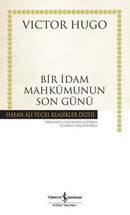Description
Last Day of a Death Penalty: “I read a book and my life changed.” The sentence gets rid of all metaphors and takes on a real meaning. Written in 1829 by the immortal writer Victor Hugo, the novel is inspired by the author's witnessing of an execution in the famous Greve Square in Paris.
The Last Day of a Death Penalty is considered a historical and social resource in that it realistically reflects 19th century France. The work, which the author published under a pseudonym when he was only 27 years old, is a critique of the political and sociological structure of the period.
A Thin Reading Experience Between Life and Death
The Last Day of a Death Penalty has an impressive narrative, written in the language of a man awaiting execution. Hugo, the strongest representative of the romance movement, makes his readers feel the fear of death and compassion with a shocking empathy. The work is also a psychological novel, as it successfully reveals the changes in the mood of a person approaching death.
Describing the execution as "the rule that revolutions cannot destroy", Hugo presents his views on this method of execution in the preface of his book, in the air of a manifesto. Afterwards, he makes the preliminary preparations of his novel with a theater play in which speeches about the book's subject are included. In this part, the author presents a different work by making his criticisms of the society and his book directly through the public.
In the last part of the novel, the author leaves the reader alone with the lines of a man who was arrested for murder and learned that he would be executed in court five weeks later. The narrator, who has become quite alienated from his life before his conviction, tells the reader a more introverted situation story. For this reason, two interchangeable emotions predominate in the novel: Hope and fear. Another striking aspect that feeds the main idea of the work is the prisoner's thoughts about people at the last moment.
First Edition Year : 2013
Language Turkish
------------------
Bir İdam Mahkumunun Son Günü ise “Bir kitap okudum ve hayatım değişti.” cümlesi, tüm mecazlardan sıyrılıp gerçek bir anlama bürünüyor. Ölümsüz yazar Victor Hugo’nun 1829 yılında kaleme aldığı roman, yazarın Paris’teki ünlü Greve Meydanı’nda gerçekleştirilen bir idama tanıklık etmesinden ilham alıyor.
Bir İdam Mahkumunun Son Günü, 19’uncu yüzyıl Fransa’sını gerçekçi bir biçimde yansıtması bakımından tarihi ve toplumsal bir kaynak olarak değerlendiriliyor. Yazarın henüz 27 yaşındayken takma bir adla yayımladığı eser, döneminin siyasi ve sosyolojik yapısına bir eleştiri niteliği taşıyor.
Hayat ve Ölüm Arasında İnce Bir Okuma Deneyimi
Bir İdam Mahkumunun Son Günü, idamı bekleyen bir adamın dilinden yazılmış olmasıyla etkileyici bir anlatıma sahip. Romantizm akımının en güçlü temsilcisi olan Hugo, ölüm korkusu ve merhamet duygularını okuruna sarsıcı bir empati ile hissettiriyor. Eser, ölüme yaklaşan bir insanın ruh halindeki değişimleri başarılı bir şekilde ortaya koyması sayesinde aynı zamanda psikolojik bir roman olma özelliği de taşıyor.
İdamı “devrimlerin yok edemediği kaide” olarak nitelendiren Hugo, kitabının ön sözünde bu infaz yöntemi hakkındaki görüşlerini okuruna bir manifesto havasında sunuyor. Sonrasında ise romanının ön hazırlığını, kitabın konusuna dair konuşmaların yer aldığı bir tiyatro piyesiyle yapıyor. Yazar, bu kısımda topluma ve kitabına karşı eleştirilerini doğrudan halktan kişiler aracılığıyla yaparak farklı bir çalışma ortaya koyuyor.
Romanın son kısmında yazar, okurunu cinayet suçu ile tutuklanan ve mahkemede beş hafta sonra idam edileceğini öğrenen bir adamın satırlarıyla baş başa bırakıyor. Mahkum edilmeden önceki yaşamına oldukça yabancılaşan anlatıcı, okura daha çok içe dönük bir durum hikayesi anlatıyor. Romanda bu nedenle birbirinin yerini alan iki duygu ağır basıyor: Umut ve korku. Eserin ana fikrini besleyen bir diğer çarpıcı yönünü ise mahkumun son anda insanlar hakkındaki düşünceleri oluşturuyor.
İlk Baskı Yılı : 2013
Dil : Türkçe
You may also like
Recently viewed
Shipping Map



